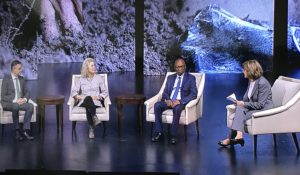
There are times when a week of conversations point to those ideas that are in need of reckoning. This past week the conversation has centered around climate change and lest you roll your eyes and check the dinner in the oven, bear with me. During the past week, conversations here on the farm spiked about adaptation and how we might act to do our small piece to contribute to solutions. As evidence mounts as to the impacts resulting from the course that we are tracking, it becomes clear that we need to commit to actions that will reverse our role in elevating levels of greenhouse gasses.
There is some thinking here that we will adapt annually. Some crops will work and others may prove themselves less than adaptable. Water – too much or too little – will shape the future of this farm. In some years, tomatoes or melons may not have enough. Living on the edge of a stream that could turn powerful with too much rainfall is also a vulnerability. It is the wide swings – too hot, too wet, not wet enough, unseasonable frosts – that may be the hardest to anticipate.
Wells supply our drinking water and 1/3 of our irrigation water. In dry years they can become dangerously low. We are dependent on fossil fuel, both to grow and to get our product to you. We are not alone in our dependence on fossil energy. Our entire food system is built on it.
In reality, the patterns and design of our culture have been shaped by cheap fossil fuel. It is a habit-forming drug that will require a tremendous will to wean ourselves from, for it is at the heart of our expectations about how we move, what we consume and how we enjoy our lives. There is a huge opportunity presenting itself as to how we break from these fuels and move to a design driven by sun, wind, and other renewables.
Modern farming has evolved with fossil fuel at its heart. The tools and techniques were cashed in on the bargain of gas, oil and diesel. The tremendous energy released from each gallon meant that a single person on increasingly large equipment could plow, fold, chisel, shape and manipulate the landscape with unimaginable speed. The standard for good ag practices became tilled bare soil with straight lines and uniform crops. It proved to be powerfully productive and clearly seductive.
First adapters of the latest tool to increase speed were the first at profits. Those were the ones who succeeded and continued to drive the search for technologies to make more for less. Fossil energy was cheap and abundant. The very design of our cities and the narrative of these tools liberating humanity from the ‘burdens of food production’ celebrated the bargain of agriculture, technology and cheap food. Yet that bargain is leaving a legacy that will require payment from future generations. Whether our expectations about food needing to be cheap, or the need to change our patterns of production, it will prove difficult to change. By some estimates, the food production system, including fertilizer manufacturing, refrigeration and transportation account for 1/3 of all greenhouse gas production.
So it was a week when a good deal of thought centered around the food system in need of rehabilitation. At the recent Global Climate Action Summit, Judith represented the farm, farmers and the farming community and spoke on a panel about the potential for agriculture to lead the way with innovative soil building, improved water management and practices that store carbon in the soil.
A small working group here in the Capay Valley – CV Regen – had its third meeting about strategies for action and on-the-ground local collaborations. The low hanging fruit includes: education (local speakers and films to address climate adaptation); getting more cover crops planted; vegetating the edges of fields with native plants and trees; designing and implementing projects that restore some of our burned mountainsides; and carbon/compost application on trial plots on Capay Valley rangeland.
We will be asking how to respond as a community by focusing on solutions that enrich the environment up here by creating more biological diversity and looking at new farming patterns that minimize moisture loss, maximize living roots in the soil and gather and sequester more carbon. We want to put carbon in the soil where it becomes key to the soil food web. It is an ambitious agenda.
These conversations took place at the same time as a dangerous hurricane and typhoon caught the world’s attention. Water and weather crises become startling reminders of the vulnerability and disruption that is possible. Perhaps our small local efforts are almost laughable in light of the scale of the issue. But helplessness is no virtue. We can begin to shape this environment that we know so intimately and maybe gain community empowerment and cohesion as a result: a good deal.
Full Belly is part of a broader farming community talking about resilience and regeneration in the face of a challenging climate. How our farm becomes more resilient by examining and changing our pattern of land use and crop production solves for the larger need of producing food while capturing more carbon in the ground and reducing greenhouse gasses while we produce that food. We can re-imagine how to create patterns of healthy new relationships that ultimately hold the key to regenerating the human spirit and its association with the land that sustains us.
—Paul Muller

From left to right, the Honorable James Shaw, Minister for Climate Change New Zealand; Judith Redmond, Full Belly Farm; Zwide Jere, Total Land Care, Malawi; and Karen Ross, Calif Dept Food and Agriculture on a panel at the Global Climate Action Summit in SF.
